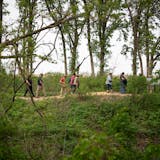COVID-19 case levels worsened in multiple counties across Minnesota, according to data released Thursday, with six mostly rural or outstate counties reaching levels at which the state recommends all online K-12 classes.
Other counties including Hennepin and Ramsey showed declines in their rates of new cases, though, amid some optimistic signs of an easing in the pandemic that has now caused 1,942 deaths and 86,722 infections with the coronavirus that causes COVID-19.
Health officials urged individuals in these counties not to become complacent and local school officials not to overreact. The state reported relatively high daily tallies on Thursday of nine deaths and 931 lab-confirmed infections.
"We're advising school policymakers to continue to be cautious in their decisionmaking," said Kris Ehresmann, state infectious disease director.
The positivity rate of diagnostic tests in Minnesota dropped from 6% in late August to 4.8%. That is below the state goal of 15%, and the 5% threshold that health officials said reflects a concerning level of viral spread.
COVID-19 hospitalization numbers remained near two-month lows on Thursday — with 242 cases in hospitals and 132 of those patients requiring intensive care.
The state has surpassed 7,000 hospitalizations for COVID-19 since its first cases emerged in March. Among all known infections, 79,878 people have recovered to the point they are no longer considered infectious.
Current COVID-19 case data do not reflect all viral transmission that occurred over the Labor Day weekend, or with the resumption of K-12 and college classes, because it can take 14 days after infection for symptoms to emerge. Then it can take another two weeks for secondary infections, which can lead to exponential growth in COVID-19 illnesses.
![Three weeks ago, Octavio Rodriguez switched from making transmission parts to casting parts for hospital bed brake assemblies at Twin City Die Castings. ] GLEN STUBBE • glen.stubbe@startribune.com Thursday, April 9, 2020 How employee-owned Twin City Die Casting, which just laid off 40 production workers of its 250 employees in what was supposed to be a good year, is trying to accelerate its pivot to growing medical parts business for ventilators, hospital beds, etc as it copes with instan](https://arc.stimg.co/startribunemedia/WNZYKGTZ5IYMUCO3KI5TR3N7WI.jpg?&w=80&ar=1:1&fit=crop)

djoles@startribune.com As boaters flock to Minnesota lakes and rivers this holiday weekend for the unofficial kick-off to the boating season, they'll face more inspections in and out of the water as local cities and counties ramp up their work to stop the spread of invasive species. Across the metro, more boat accesses will be staffed by watercraft inspectors thanks to $10 million funneled to county government programs this year, up from $4.5 million the state allocated last year. ORG XMIT: MIN1505222156290209 ORG XMIT: MIN1506021218440580](https://arc.stimg.co/startribunemedia/34QSKO44B2XKVNUZCO5SLJQSLY.jpg?&w=80&ar=1:1&fit=crop)
